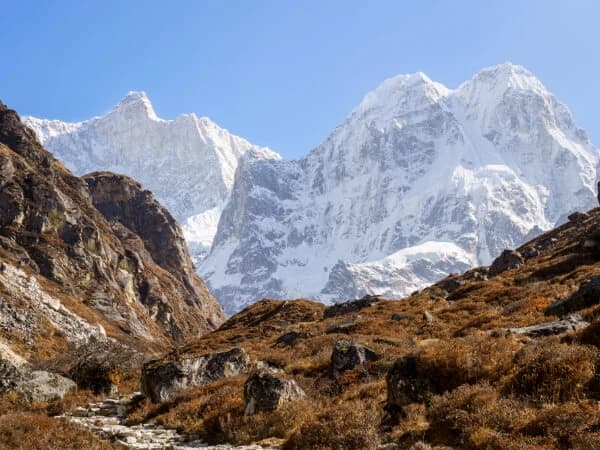Highlights of Kanchenjunga Region Trekking
- Remote and unspoiled trekking experience.
- Rich cultural encounters with local communities.
- Diverse landscapes from forests to high-altitude deserts.
- Stunning views of Kanchenjunga, the world's third-highest peak.
- Abundant wildlife in the Kanchenjunga Conservation Area.
- Challenging and rewarding trails for experienced trekkers.
- Multiple trekking route options, including the base camps and circuit.
- Excellent photography opportunities in dramatic settings.
- Peace and solitude with fewer tourists.
- Best trekking conditions during pre-monsoon and post-monsoon seasons.
How to Prepare for Your Kanchenjunga Region Trek
Physical Fitness and Acclimatization
Physical preparation is essential for trekking in the Kanchenjunga region. The trails are rugged, and the altitudes are high, so you need to be in excellent shape. Cardiovascular training, strength training, and flexibility exercises should be part of your routine. Acclimatization is equally important. Spend a few days at a lower altitude before you start your trek to give your body time to adjust.
Essential Gear and Equipment for the Kanchenjunga Trek
Your gear can make or break your trek. Key items include a good-quality sleeping bag, a reliable tent (if camping), layers of warm clothing, waterproof gear, sturdy trekking boots, and a well-fitting backpack. Don’t forget essentials like a first aid kit, water purification tablets, and trekking poles.
Navigating the Challenges: Altitude Sickness and Weather Conditions
Altitude sickness is a real risk in the Kanchenjunga region. It’s crucial to recognize the symptoms, which include headaches, dizziness, and nausea. To minimize the risk, ascend slowly and stay hydrated. Weather conditions can also be unpredictable, so be prepared for everything from scorching sun to snowstorms. Check the weather forecasts regularly and adjust your plans accordingly.
Permits and Regulations for Trekking in the Kanchenjunga Region
Trekking in the Kanchenjunga region requires several permits, including a Restricted Area Permit (RAP) and a Trekking Information Management System (TIMS) card. These permits are essential and can be arranged through a registered trekking agency. Make sure you have these permits in place before you start your trek.
Packing List for the Kanchenjunga Trek
Here’s a quick packing checklist to ensure you have everything you need:
- Clothing: Layered clothing, waterproof jacket, thermal underwear, gloves, and hats.
- Footwear: Sturdy trekking boots, extra socks, sandals for camp.
- Gear: Sleeping bag, tent (if camping), trekking poles, headlamp.
- Essentials: First aid kit, water purification tablets, map, compass, and multi-tool.
Accommodation and Facilities
Accommodation Options on the Trek
Accommodation in the Kanchenjunga region is basic but adequate. Most trekkers stay in teahouses, which offer simple rooms and communal dining areas. Teahouses are spaced out along the trekking routes, but in some remote areas, you may need to camp. Be prepared for cold nights and bring a good sleeping bag.
Food and Water: What to Expect
Meals in the Kanchenjunga region typically consist of dal bhat (rice and lentils), noodles, and potatoes. The food is simple but filling. Clean drinking water can be a challenge, so it’s essential to carry water purification tablets or a filter. Boiled water is usually available at teahouses.
When Is the Best Time to Trek in the Kanchenjunga Region?
Seasonal Weather Patterns and Their Impact on Trekking
The best time to trek in the Kanchenjunga region is during the pre-monsoon (March to May) and post-monsoon (September to November) seasons. During these periods, the weather is relatively stable, and the skies are clear, offering the best views of the mountains.
Pros and Cons of Trekking in Different Seasons
- Spring (March to May): Warmer temperatures, blooming rhododendrons, but busier trails.
- Autumn (September to November): Clear skies, cool temperatures, but more crowded.
- Winter (December to February): Cold temperatures, snow-covered trails, fewer trekkers.
- Monsoon (June to August): Heavy rains, slippery trails, and limited visibility.
Peak Season vs. Off-Season Trekking Experiences
Peak season (spring and autumn) offers the best conditions but attracts more trekkers. Off-season trekking is quieter and offers a more solitary experience, but the weather can be challenging.
Challenges and Rewards of Kanchenjunga Trekking
Terrain and Trail Conditions
The terrain in the Kanchenjunga region is rugged and varied. Expect steep ascents, rocky paths, and narrow trails. The trails are less developed than those in other regions, adding to the challenge but also the sense of adventure.
Weather Conditions and Best Time to Trek
Weather in the Kanchenjunga region can be unpredictable. The best time to trek is during the stable weather periods of spring and autumn. Always be prepared for sudden changes, and pack accordingly.
Photographic Opportunities
Best Spots for Photography
The Kanchenjunga region offers countless opportunities for stunning photography. Key spots include the North and South Base Camps, the Lumba Sumba Pass, and the Yalung Glacier. Early mornings and late afternoons provide the best light for capturing the dramatic landscapes.
Tips on Photography in High-Altitude Environments
Photographing in high altitudes requires some special considerations. Tips include keeping your batteries warm (cold temperatures drain them quickly) and using a UV filter to reduce glare from the snow. Be mindful of the weather and protect your equipment from moisture.
Sharing Your Trekking Experience
Sharing your experience is a great way to contribute to the trekking community. Whether through social media, blogs, or photo galleries, your story can inspire others to explore the Kanchenjunga region.
Logistics for the Kanchenjunga Trek
Transportation Options to Reach the Starting Point
The starting point for the Kanchenjunga trek is usually Taplejung, which is accessible by a domestic flight from Kathmandu to Bhadrapur, followed by a long drive. Another option is to take a bus from Kathmandu, but the journey is lengthy and challenging.
Accommodation and Food Options During the Trek
As mentioned earlier, accommodation is primarily in teahouses, with camping as an option in more remote areas. Food is basic but sufficient, with dal bhat being the staple meal. It’s advisable to carry some high-energy snacks and supplements for the trek.



